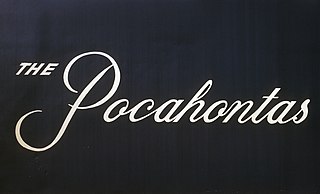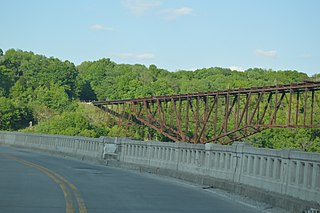The Cleveland, Cincinnati, Chicago and St. Louis Railway, also known as the Big Four Railroad and commonly abbreviated CCC&StL, was a railroad company in the Midwestern United States. It operated in affiliation with the New York Central system.

The Marietta and Cincinnati (M&C) was one of five important east-west railroads of southern Ohio; it was later absorbed by the Baltimore and Ohio Railroad (B&O). Its original route ran from Marietta through Vincent, Athens, Hamden, Chillicothe, Greenfield, Blanchester, and Loveland. It had two main branches: Blanchester to Hillsboro, which was originally part of the Hillsboro and Cincinnati Railroad; and Hamden to Portsmouth, Ohio, originally part of the Scioto and Hocking Valley Railroad.

The Seaboard Air Line Railroad, which styled itself as "The Route of Courteous Service", was an American railroad that existed from April 14, 1900, until July 1, 1967, when it merged with the Atlantic Coast Line Railroad, its longtime rival, to form the Seaboard Coast Line Railroad. Predecessor railroads dated from the 1830s and reorganized extensively to rebuild after the American Civil War. The company was headquartered in Norfolk, Virginia, until 1958, when its main offices were relocated to Richmond, Virginia. The Seaboard Air Line Railway Building in Norfolk's historic Freemason District still stands and has been converted into apartments.

The Cincinnati, Lebanon and Northern Railway (CL&N) was a local passenger and freight-carrying railroad in the southwestern part of the U.S. state of Ohio, connecting Cincinnati to Dayton via Lebanon. It was built in the late 19th century to give the town of Lebanon and Warren County better transportation facilities. The railroad was locally known as the "Highland Route", since it followed the ridge between the Little and Great Miami rivers, and was the only line not affected by floods such as the Great Dayton Flood of 1913.
The Cincinnati, New Orleans and Texas Pacific Railway is a railroad that leases the Cincinnati Southern Railway from Cincinnati, Ohio, south to Chattanooga, Tennessee, and sub leases it to the Norfolk Southern Railway system.

The Cincinnati, Hamilton and Dayton Railway (CH&D) was a railroad based in the U.S. state of Ohio that existed between its incorporation on March 2, 1846, and its acquisition by the Baltimore and Ohio Railroad in December 1917. It was originally chartered to build from Cincinnati to Hamilton, Ohio, and then to Dayton, a distance of 59 mi (95 km); further construction and acquisition extended the railroad, and by 1902 it owned or controlled 640 mi (1,030 km) of railroad. Its stock and bond value plunged in late 1905 after "financial mismanagement of the properties" was revealed. The company was reorganized as the Toledo and Cincinnati Railroad in 1917.

The Pittsburgh, Cincinnati, Chicago and St. Louis Railroad, commonly called the Pan Handle Route, was a railroad that was part of the Pennsylvania Railroad system. Its common name came from its main line, which began at Pittsburgh, Pennsylvania, crossed the Northern Panhandle of West Virginia, and continued west to Bradford, Ohio, where it split into a northern line to Chicago and a southern one through Indianapolis, Indiana, to East St. Louis, Illinois.

The Pocahontas was one of the named passenger trains of the Norfolk and Western Railway. It ran overnight between Norfolk, Virginia, and Cincinnati, Ohio, with a through-car to and from Chicago, Illinois. The Pocahontas ran from November 1926 until May 1971.
The Cincinnati District is a railroad line owned by the Norfolk Southern Railway and operated by Cincinnati Eastern Railroad in the U.S. state of Ohio. The line runs from Cincinnati, Ohio, southeast to Portsmouth, Ohio, along a former Norfolk and Western Railway line. Its southeast end is at the Columbus District near Portsmouth, while its northwest end is in Mariemont, Ohio, where it meets the Indiana and Ohio Railway's Midland Subdivision and Norfolk Southern's Dayton District.
The Cincinnati Northern Railroad was a railroad that stretched from Franklin, Ohio, north to Jackson, Michigan, a distance of about 186 miles (299 km). It was acquired by the Cleveland, Cincinnati, Chicago and St. Louis Railway in 1901 and the New York Central Railroad several years later. Most of the line has since been abandoned.

The Cincinnati, Indianapolis and Western Railroad was established in 1915 as a reorganization of the Cincinnati, Indianapolis and Western Railway, which in turn had been created in 1902 as a merger of the Indiana, Decatur and Western Railway (ID&W) and the Cincinnati, Hamilton and Indianapolis Railroad (CH&I).
The Frankfort and Cincinnati Model 55 Rail Car is a historic railcar on the National Register of Historic Places. The railcar currently resides at the Kentucky Railway Museum in New Haven, Nelson County, Kentucky.

The Frankfort and Cincinnati Railroad is a defunct shortline railroad based in Kentucky. Despite its name, it had no connections with Cincinnati, Ohio.
Transportation in Kentucky includes roads, airports, waterways and rail.
The following is a brief history of the North American rail system, mainly through major changes to Class I railroads, the largest class by operating revenue.

Norfolk Terminal Station was a railroad union station located in Norfolk, Virginia, which served passenger trains and provided offices for the Norfolk and Western Railway, the original Norfolk Southern Railway and the Virginian Railway. The N&W, Norfolk Southern, and Virginian's Norfolk terminal location stood in contrast to competitor railroads, such as the Chesapeake & Ohio Railroad, Southern Railway, Atlantic Coast Line Railroad, Pennsylvania Railroad and Seaboard Air Line Railroad which operated out of Cape Charles (Virginia), Newport News and Portsmouth, terminals outside of Norfolk. Customers took ferries or, later in the 20th century, buses from Norfolk to reach those other terminals. The terminal was located at 1200 East Main Street in Norfolk, near today's Harbor Park baseball stadium.
The Charleston, Cincinnati and Chicago Railroad, informally known as the Triple C, was a Southeastern railroad that operated in the late 19th century.

The Louisville Southern Railroad was a 19th-century railway company in the U.S. state of Kentucky. It operated from 1884 until 1894, when it was incorporated into the Southern Railway in Kentucky.











